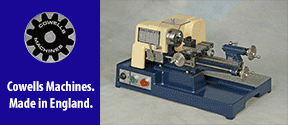Dial graduations versus feedscrew lead.
| blowlamp | 21/05/2012 11:39:15 |
1885 forum posts 111 photos | A friend has just purchased an Osaki mini milling machine from Cromwell Tools.
It looks similar to the ones offered by Machine Mart and Arceurotrade etc, but I was surprised to find the handwheels are graduated to 0.75mm per rev Does anybody have an explanation for this? I might add that a complaint has been made to the supplier and they state that all their machines are the same and so can't fit more appropriate handwheels. They are however, willing to collect and refund his payment.
Martin. |
| KWIL | 21/05/2012 12:15:59 |
| 3681 forum posts 70 photos |
Upon reading the Instruction Manual (on Cromwell site) it is supplied with a "fuselage" and that you need "cake" to attach an item to the table. All Chinglish of course |
| PekkaNF | 21/05/2012 13:44:08 |
| 96 forum posts 12 photos | Only one reasonable thing comes to my mind: Some lathes has cross slide handwheel/thimble graduted to show progress in DIAMETER. I can't be sure which brand it was but I'm pretty sure I saw least one long time ago. Could it be possible, that maker had copied this consept to lathe and oneday they had surplus of lathe handles and they were wheeled to a half ready batch milling machines? Then again it could be any combination of hanwheels/lead of the feed screw and metric/imperial concotion combined with one digit error on order code. I have seen handles "calibrated" with 0-100 readings with aproximate mm/" markking, neither of them was accurate, even tough feed screw had nice 3 mm/r lead. Pekka |
| blowlamp | 21/05/2012 14:01:23 |
1885 forum posts 111 photos | KWIL. At a push, with a good wind behind me, I could just about go with 'fuselage' to describe the body of the machine. On the other hand, 'cake' makes me wonder what the author had on his mind at the time of writing. Pekka. I've got a lathe with a cross feed dial like that, but that's actually opposite to the situation on the milling machine, because the lathe dial is graduated 5mm per turn coupled with a 2.5mm pitch feedscrew.
Martin. |
| 1 | 21/05/2012 14:43:16 |
| 65 forum posts 1 photos | Just a though since this do seem to be a strange machine, have you checked that the 1.5mm indicated table movement is actually 1.5mm? Jim |
| Joseph Ramon | 21/05/2012 15:12:31 |
107 forum posts | Kwil My machine (seig version) has 75 graduations of 0.02mm and 1.5mm of feed per turn of the handwheel and is clearly marked as such. Are you assuming that the 75 graduations are 0-.01mm each? 60 graduations would be a much better choice for both metric and imperial work. Joey |
| Ady1 | 21/05/2012 15:16:39 |
6137 forum posts 893 photos | Sounds like the 0.02mm is ok to me
Pultra 1590s did 100 graduations on a 2mm leadscrew 0.02mm a pop |
| wheeltapper | 21/05/2012 15:21:47 |
424 forum posts 98 photos | I just read the pdf for this machine, I just love reading chinglish, it's so much better than the telly. there is one thing that looks very useful tho, under cutter maintainance is says " wrong rotating direction may cause sharpness".
looks like they are on to something there, instant tool sharpener!!!!
Roy.
|
| KWIL | 21/05/2012 16:50:51 |
| 3681 forum posts 70 photos | Joey, Not me, I did not comment upon the divisions in any way. Merely the Chinglish Manual. KWIL |
| blowlamp | 21/05/2012 17:19:44 |
1885 forum posts 111 photos | I decided to contact Arceurotrade to find out about their equivalent machine. I have been told that the feedscrews fitted to the Arceurotrade machine are of 2mm pitch and the dials have 80 divisions, so that equates to 0.025mm per division, which is quite understandable to me because it's also pretty close to 0.001". So a good compromise for metric vs imperial when getting down to finished size.
Martin. |
| Ian Fowkes | 21/05/2012 20:49:57 |
31 forum posts 1 photos | My Axminster (Sieg) mill has 75 0.02mm graduations on x and y axis handwheel and 60 0.025 graduations on z, 1.5mm per revolution in all cases. It is confusing having a different scale on the z axis but must be Chinese logic. My machine also has a fuselage, Chinglish for column I believe. Ian. |
| blowlamp | 21/05/2012 21:44:11 |
1885 forum posts 111 photos | Just been thinking about this again... I take it that the Arceurotrade 80 div dials and 2mm pitch feedscrews are graduated as something like:- 12 O'clock = 0/2mm, 3 O'clock = 0.5mm, 6 O'clock = 1mm and 9 O'clock = 1.75mm, rather than just numbered from 1 to 80. Anyone know for sure which way they've done it?
Martin. |
Please login to post a reply.
Want the latest issue of Model Engineer or Model Engineers' Workshop? Use our magazine locator links to find your nearest stockist!
Sign up to our newsletter and get a free digital issue.
You can unsubscribe at anytime. View our privacy policy at www.mortons.co.uk/privacy
- *Oct 2023: FORUM MIGRATION TIMELINE*
05/10/2023 07:57:11 - Making ER11 collet chuck
05/10/2023 07:56:24 - What did you do today? 2023
05/10/2023 07:25:01 - Orrery
05/10/2023 06:00:41 - Wera hand-tools
05/10/2023 05:47:07 - New member
05/10/2023 04:40:11 - Problems with external pot on at1 vfd
05/10/2023 00:06:32 - Drain plug
04/10/2023 23:36:17 - digi phase converter for 10 machines.....
04/10/2023 23:13:48 - Winter Storage Of Locomotives
04/10/2023 21:02:11 - More Latest Posts...
- View All Topics
- Reeves** - Rebuilt Royal Scot by Martin Evans
by John Broughton
£300.00 - BRITANNIA 5" GAUGE James Perrier
by Jon Seabright 1
£2,500.00 - Drill Grinder - for restoration
by Nigel Graham 2
£0.00 - WARCO WM18 MILLING MACHINE
by Alex Chudley
£1,200.00 - MYFORD SUPER 7 LATHE
by Alex Chudley
£2,000.00 - More "For Sale" Ads...
- D1-3 backplate
by Michael Horley
Price Not Specified - fixed steady for a Colchester bantam mark1 800
by George Jervis
Price Not Specified - lbsc pansy
by JACK SIDEBOTHAM
Price Not Specified - Pratt Burnerd multifit chuck key.
by Tim Riome
Price Not Specified - BANDSAW BLADE WELDER
by HUGH
Price Not Specified - More "Wanted" Ads...
Do you want to contact the Model Engineer and Model Engineers' Workshop team?
You can contact us by phone, mail or email about the magazines including becoming a contributor, submitting reader's letters or making queries about articles. You can also get in touch about this website, advertising or other general issues.
Click THIS LINK for full contact details.
For subscription issues please see THIS LINK.
Model Engineer Magazine
- Percival Marshall
- M.E. History
- LittleLEC
- M.E. Clock
ME Workshop
- An Adcock
- & Shipley
- Horizontal
- Mill
Subscribe Now
- Great savings
- Delivered to your door
Pre-order your copy!
- Delivered to your doorstep!
- Free UK delivery!










 Register
Register Log-in
Log-in


